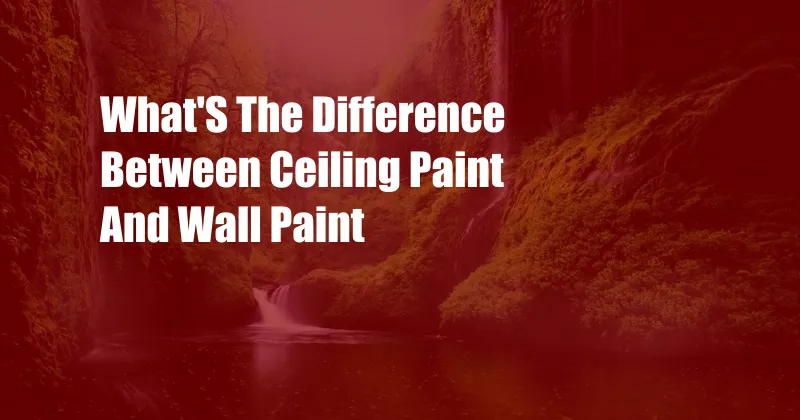
What’s the Difference Between Ceiling Paint and Wall Paint?
Have you recently embarked on a DIY painting project and found yourself pondering the distinction between ceiling paint and wall paint? I vividly recall the first time I encountered this dilemma; it occurred when I was embarking on the ambitious task of transforming my living space into a vibrant and inviting haven. As I stood in the hardware store, the overwhelming array of paint options left me feeling perplexed and uncertain.
However, I persevered, determined to unravel the secrets behind these two types of paint. Armed with newfound knowledge, I confidently selected the perfect paints for my ceiling and walls, resulting in a flawless and awe-inspiring transformation. In this comprehensive article, I will share my insights and expertise on the differences between ceiling paint and wall paint, empowering you to make informed decisions for your next painting project.
Flat vs. Sheen: The Key Difference
The fundamental distinction between ceiling paint and wall paint lies in their respective finishes—flat and sheen. Flat paint, as its name suggests, possesses a matte finish that effectively conceals surface imperfections, making it an ideal choice for ceilings. Conversely, sheen paint, available in a range of finishes from eggshell to semi-gloss, imparts a subtle sheen to walls, enhancing their durability and resistance to moisture and stains.
Ceiling paint is formulated specifically for application on ceilings, where its flat finish effortlessly camouflages blemishes and minimizes the appearance of uneven surfaces. Wall paint, on the other hand, is designed to withstand the rigors of everyday wear and tear, making it an excellent choice for walls subject to frequent traffic and potential spills.
Benefits of Flat Ceiling Paint
Flat ceiling paint offers several compelling advantages:
- Excellent Coverage: Flat paint’s thick consistency ensures exceptional coverage, effectively concealing imperfections and creating a uniform, flawless surface.
- Minimal Glare: The matte finish of flat paint effectively absorbs light, eliminating glare and creating a soft, inviting ambiance.
- Easy Application: Flat paint is relatively easy to apply, reducing the likelihood of drips or streaks.
Benefits of Sheen Wall Paint
Sheen wall paint also provides a range of practical benefits for your walls:
- Enhanced Durability: Sheen paint forms a protective layer over your walls, increasing their resistance to scratches, scuffs, and stains.
- Moisture Resistance: The sheen finish repels moisture to some extent, making it suitable for areas prone to humidity or condensation.
- Easy Cleaning: Sheen paint’s smooth surface can be easily wiped clean with a damp cloth.
Latest Trends in Ceiling and Wall Paint
The world of paint is constantly evolving, with new trends emerging every year. Here are some of the latest developments in ceiling and wall paints:
- Environmentally Friendly Paints: Eco-conscious consumers are increasingly opting for low-VOC (volatile organic compound) and VOC-free paints that minimize indoor air pollution.
- Metallic Finishes: Metallic accents are becoming popular for both ceilings and walls, adding a touch of glamour and sophistication to any space.
- Textured Finishes: Textured paints can create unique and eye-catching effects on both ceilings and walls, adding depth and dimension.
Tips and Expert Advice
Based on my experience as a home improvement enthusiast, here are some tips and expert advice to ensure a successful painting project:
- Surface Preparation: Proper surface preparation is crucial for achieving a smooth and durable finish. Clean and sand the surface thoroughly before applying paint.
- Use High-Quality Brushes and Rollers: Invest in high-quality brushes and rollers specifically designed for ceiling and wall painting.
- Apply Two Coats: Always apply two coats of paint for optimal coverage and durability. Allow ample time for each coat to dry before applying the next.
FAQ on Ceiling and Wall Paint
- Q: Can I use ceiling paint on walls?
- A: While ceiling paint can be used on walls, it is not recommended as it does not offer the same level of durability and resistance to moisture and stains.
- Q: What is the best finish for a ceiling?
- A: Flat paint is the preferred finish for ceilings as it effectively hides imperfections and reduces glare.
- Q: How do I choose the right color for my ceiling?
- A: White is a classic choice for ceilings as it creates a clean and airy feel. However, you can also opt for subtle shades of gray or beige.
- Q: How often should I repaint my ceiling?
- A: Ceilings generally require repainting less frequently than walls, but it is recommended to refresh them every 5-7 years.
Conclusion
Understanding the differences between ceiling paint and wall paint is essential for achieving a successful and aesthetically pleasing painting project. By carefully considering the finish, durability, and specific requirements of your space, you can select the ideal paints to enhance the beauty and functionality of your home. Whether you prefer the subtle elegance of flat ceiling paint or the practical advantages of sheen wall paint, the possibilities are endless.
Are you interested in learning more about painting techniques, color selection, or home improvement projects? Share your questions and comments below, and I will be happy to provide my insights and expertise.